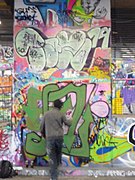Characteristics of common graffiti

Methods and production
The modern-day graffitists can be found with an arsenal of various materials that allow for a successful production of a piece. This includes such techniques as scribing. However, spray paint in aerosol cans is the number one medium for graffiti. From this commodity comes different styles, technique, and abilities to form master works of graffiti. Spray paint can be found at hardware and art stores and comes in virtually every color.
Stencil graffiti is created by cutting out shapes and designs in a stiff material (such as cardboard or subject folders) to form an overall design or image. The stencil is then placed on the "canvas" gently and with quick, easy strokes of the aerosol can, the image begins to appear on the intended surface.
- Graffiti making

The first graffiti shop in Russia was opened in 1992 in Tver

Graffiti application at Eurofestival in Turku, Finland
Graffiti application in India using natural pigments (mostly charcoal, plant saps, and dirt)

Completed landscape scene, in Thrissur, Kerala, India
A graffiti artist at work in London
Modern experimentation
Modern graffiti art often incorporates additional arts and technologies. For example, Graffiti Research Lab has encouraged the use of projected images and magnetic light-emitting diodes (throwies) as new media for graffitists. Yarnbombing is another recent form of graffiti. Yarnbombers occasionally target previous graffiti for modification, which had been avoided among the majority of graffitists.
Tagging
A number of recent examples of graffiti make use of hashtags.





Comments
Post a Comment